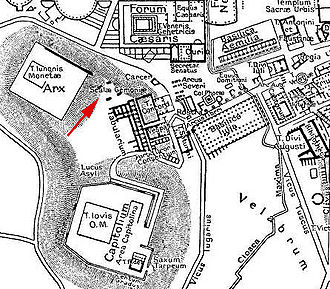Gemonic stairs
The Gemonische Staircase is an ancient staircase in Rome , which - possibly partially identical to today's Via di S. Pietro in Carcere - led from the Capitol via the Roman Forum to the Tiber and ran along the state prison, the Carcer Tullianus .
First mentioned are the stages called scalae Gemoniae in Latin during the reign of Tiberius . The name is erroneously derived from the Latin gemo (i.e. I sigh), but rather comes from the proper name Gemonius. As evidently first under Tiberius, the Gemonische Staircase was also used as a place for executions or as a place for the public exhibition of the executed in the following Roman Empire . Among the first whose bodies were exhibited there with dishonorable intentions was the Praetorian prefect Lucius Aelius Seianus in 31 . Tiberius suspected him of plotting the murder of his designated successor Caligula and had him and his family executed. In the period that followed, other alleged conspirators fell victim to the persecution of Tiberius and some of them were exhibited on the Gemonian Staircase. The Roman Emperor Vitellius was among those who were mocked, tortured and executed there in 69. The role of the staircase in public executions of alleged enemies of the state is attested in the 5th century .
What went on on the Gemonian Staircase didn't always follow the same pattern. After the execution in the Tullianum , the traditional execution chamber of Carcer Tullianus , or the execution on the Gemonian Staircase itself, the corpse was sometimes left there until the decomposition had progressed, or it was dragged down the stairs through the city with a hook. There is also talk of some corpses being torn apart by an angry mob or animals. After the public display, which served to dishonor the delinquents , the remains were usually thrown into the Tiber so that they drifted down into the Tyrrhenian Sea .
Pliny the Elder reports on the dog of a follower of Titus Sabinus , who in the year 28 stayed for a long time with his slain master on the Gemonian Staircase, brought him meat to eat and, when the corpse was thrown into the Tiber, finally jumped after and tried to to save the dead from sinking.
According to the ancient Roman concept of the hereafter, the dead floating in the sea were denied access to the underworld . The loss of face and the denial of access to the hereafter must have exacerbated the threat of this type of execution many times over in the ancient Roman imagination. So says Suetonius with the intention to emphasize the cruelty of Tiberius during his last years, these have not let a day without execution, and all those executed - 20 per day - had been thrown on the Gemonian stairs and dragged with hooks to the Tiber.
literature
- Konrat Ziegler : Gemoniae scalae. In: Paulys Realencyclopädie der Classischen Antiquity Science . Vol. 13, 1910, Col. 1115-1116.
- Scalae Gemoniae . In: Samuel Ball Platner : A Topographical Dictionary of Ancient Rome . Completed and revised by Thomas Ashby . Oxford University Press, London 1929, p. 466.
- Christoff Neumeister : Ancient Rome. A literary city guide . 2nd revised edition. Beck, Munich 1993, ISBN 3-406-35375-4 , p. 71.
- Herbert Alexander Stützer: Ancient Rome. The city of the seven hills. Places, monuments, works of art, history and life in ancient Rome . DuMont, Cologne 1979, ISBN 3-7701-1099-4 , ( DuMont documents - art travel guide ), p. 94f.
Individual evidence
- ^ Wilhelm Schulze: On the history of Latin proper names . Berlin 1904, p. 108ff.
- ^ Tacitus : Annals . 5.9 , where it is reported that, as there was no precedent for the execution of a virgin, the daughter of Seianus was raped by the executioner before she was strangled and thrown onto the Gemonian Staircase. See Suetonius : Tiberius . 61.5 .
- ^ Cassius Dio : Roman History . Book LVIII, 11.5 .
- ↑ See John W. Burke: Emblematic Scenes in Suetonius' Vitellius . In: Histos 2, 1998, especially note 6 .
- ^ Sallust : The Catilinarian Conspiracy . 55, 3-6 .
- ↑ Naturalis historia , Book VIII, 145 ( Eng. ).
- ↑ Cf. Cassius Dio: Roman History . Book LVIII, 1.3 .
- ^ Suetonius: De Vita Caesarum: Tiberius . 61 .
Coordinates: 41 ° 53 '36.99 " N , 12 ° 29' 2.47" E
